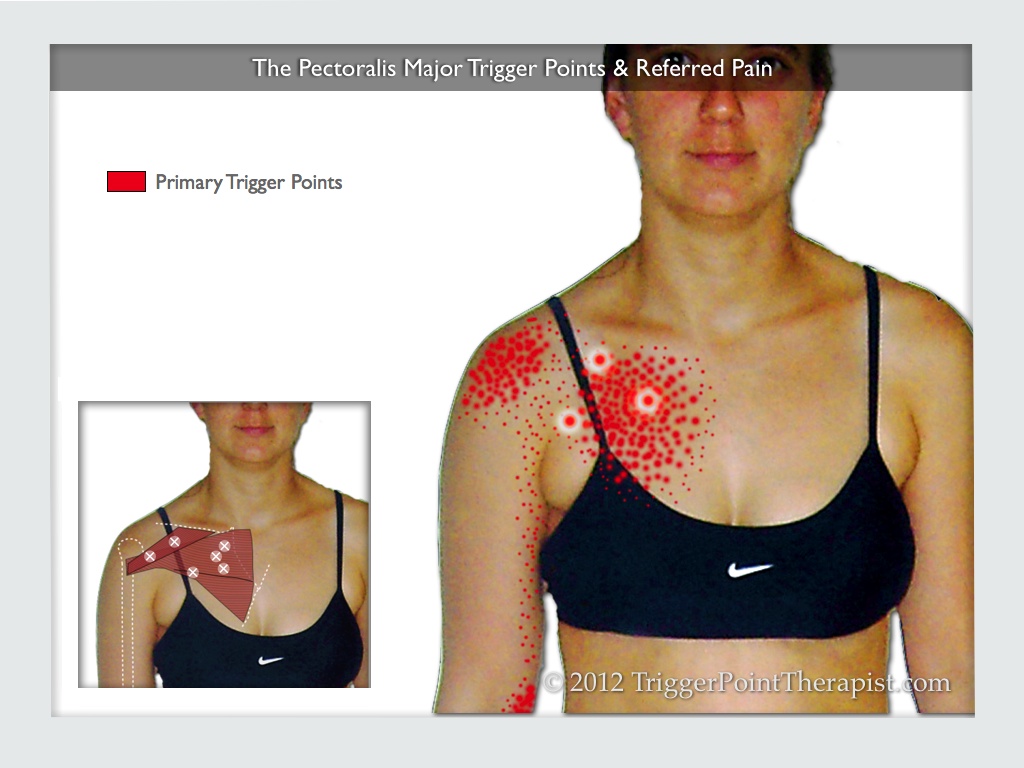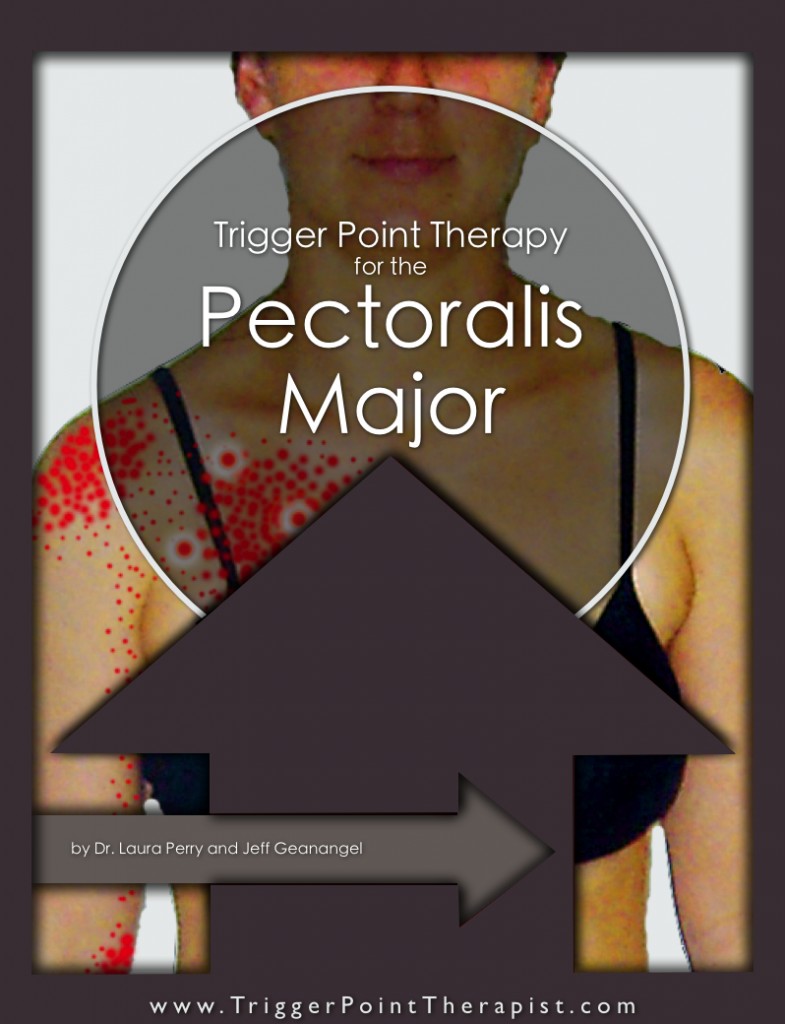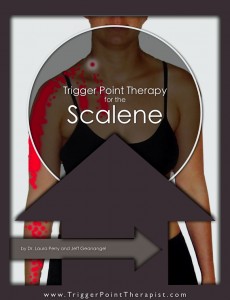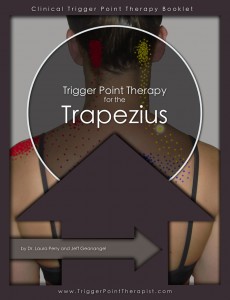First and foremost, everything written below assumes that a cardiac source of chest pain has been ruled out by a cardiologist. It’s absolutely imperative that if your client (or the reader) is experiencing chest pain, they (or you) should immediately be examined by a cardiologist. Only after being cleared by a cardiologist should this myofascial source of chest pain be investigated.
The trigger points in the pectoralis major muscle (a.k.a the “pecs”) can produce symptoms that are nearly identical to the pain associated with having a heart attack or angina pectoris. Referred pain from these trigger points is experienced in the chest, front of the shoulder, down the inside of the arm, and along the inside of the elbow. They may also produce tenderness in the breast and nipple hypersensitivity.
These trigger points also have an intimate connection with upper body posture, and can have far reaching effects on the muscle groups in this region.
The Pectoralis Major Muscle
Location: The pectoralis major is the muscle that forms the bulk of the chest.
Function: This muscle is particularly active during forward swinging motions of the arm, such as when throwing a ball, batting a ball, swinging a golf club, swinging a tennis racket, and certain swimming strokes.
Muscle Structure & Attachments: The pectoralis major has three major fiber divisions that are fanned out in a playing card -type of arrangement:
- The clavicular division originates along the medial half of the clavicle and runs diagonally downward and laterally to attach to the greater tubercle of the humerus (upper arm) bone. This is the most superior and superficial division of the muscle fibers.
- The sternal division originates along the sternum (chest) bone and runs laterally to attach to the greater tubercle of the humerus. This is the middle division (and layer) of muscle fibers and comprises the bulk of the muscle.
- The costal division originate on the costal cartilages of the ribs and run diagonally upward and laterally to attach to the greater tubercle of the humerus. These are the most inferior and deepest fibers of the muscle and they are partially covered by the sternal division fibers.
Note: Some anatomical textbooks recognize only two divisions in the pectoralis muscle, the clavicular and sternal, in which the sternal and costal divisions described above are combined into one division.
The skeletal landmarks and muscular attachments of the pectoralis major are shown in the excerpt from the Trigger Point Therapy for the Pectoralis Major Video Download.
Muscle Actions:
- Contracting as a whole, the pectoralis major produces adduction and medial rotation of the upper arm at the shoulder. It pulls the arm towards the body.
- Contraction of the upper (clavicular) fibers assists with flexion of the upper arm at the shoulder.
- Contraction of the lower (costal) fibers depresses the shoulder girdle.
Biomechanical Considerations: Chronic tension in the pectoralis major perpetuates the all too common rounded shoulder-sunken chest postural distortion. This causes the trapezius and rhomboid muscles in the upper back to become overstretched and weakened, predisposing them to trigger point activity.
Another component of this postural distortion is forward placement of the head, which places the scalene and sternocleidomastoid muscles in a shortened position, predisposing them to trigger point activity as well.
Releasing the trigger points in the pectoralis muscle is the key to correcting this postural distortion and the neck and mid-back pain conditions that are perpetuated by it.
The Pectoralis Major Trigger Points
The diagram below shows the three primary pectoralis major trigger points:
- The two clavicular trigger points are the most lateral in the muscle.
- The sternal trigger point is the most centrally located, and actually represents a cluster of two to three trigger points situated very close together.
Pectoralis Muscle Pain
The diagram above also shows the referred pain patterns associated with these trigger points.
- The clavicular trigger points refer pain to the anterior aspect of the shoulder.
- The sternal trigger point cluster refers pain to the chest, down the inside of the upper arm to the inner elbow region, and into the middle, ring, and pinky fingers.
It should be noted that two other trigger points may be present in this muscle, but they occur so infrequently that I rarely address them. One of them is a trigger point along the outside margin of the lower costal fibers that refers pain and tenderness to the breast (and causes nipple hypersensitivity).
The other is a centrally located trigger point in the costal fibers on the right side of the chest that causes cardiac arrhythmia (irregular heartbeat). I have no clinical experience with this trigger point but I find it fascinating that a trigger point in the muscle on the right side of the chest (opposite side from the heart) can have such an influence on the functioning of the heart.
Pectoralis Major Symptoms & Disorders
Clients with active pectoralis major trigger points will present with any or all of the following symptoms or clinical findings:
- Chest pain, front shoulder pain, and pain down the inside of the left arm to the elbow. If this referred pain occurs on the person’s left side, it can be confusingly similar to cardiac pain. Important Note: All cases of left-sided chest pain should be considered as cardiac in origin until they are ruled out by a cardiologist.
- Pain may extend into the ring and pinky fingers of the hand.
- A concurrent or simultaneous pain in the mid-back region (between the shoulder blades) may be present.
- Pain in the breast and/or nipple hypersensitivity may occur.
- Impaired lymphatic drainage may cause the breast to enlarge.
- Pain may cause a feeling of constriction in the chest, similar to that of angina pectoris.
- Pain is intermittent, usually occurring with activity of the upper arms, but may also occur at rest if trigger point activity is intense.
- Pain may start as unilateral, but typically spreads to both sides of the chest.
- The motion of spreading the arms wide may feel restricted.
- Symptoms associated with active Sternocleidomastoid trigger points may occur secondarily to symptoms described here.
What Causes Pectoralis Major Trigger Points?
The following events or activities may activate or reactivate the pectoralis major trigger points:
- Head-forward, rounded-shoulder, sunken-chest posture as previously described. Sitting in front of a computer for long periods promotes this postural distortion.
- Heavy lifting, especially with the arms out in front of the body
- Use of hedge clippers or power saw
- Immobilization of arm (arm in a cast)
- Chilling of the muscle, especially when the muscle is fatigued
- High levels of anxiety or reoccurring panic attacks
- Pain from a previous heart attack, or angina pain, may active the trigger points in this muscle.
Related Disorders
- Myocardial Infarction or Angina Pectoris: Chest pain originating from a heart attack or coronary insufficiency must be ruled out by a cardiologist before trigger point therapy treatment is indicated. Pain from a current or previous cardiac event may be perpetuated by pectoralis major trigger points.
- Thoracic Outlet Syndrome: Referred pain from the pectoralis major, pectoralis minor, and scalene muscles can mimic the symptoms associated with thoracic outlet syndrome.
- Pectoralis Muscle Tear: A tear in the muscle belly causes intense and immediate pain in the chest.
- Bicepital Tendonitis: The clavicular trigger points in this muscle, along with the infraspinatus trigger points, can mimic the frontal shoulder and upper arm pain associated with bicepital tendonitis. Also, the pectoralis major is easily overloaded by activities commonly associated with this condition, such as throwing a baseball.
- Medial Epicondylitis or “Golfer’s Elbow”: Referred pain from pectoralis major trigger points, as well as that from some triceps trigger points, focuses strongly on the inside aspect of the elbow, resembling the symptoms associated with golfer’s elbow.
Treatment of Pectoralis Major Trigger Points
For step-by-step instructions for releasing these trigger points please purchase the Trigger Point Therapy for the Pectoralis Major Video Download or the Trigger Point Therapy for the Pectoralis Major Booklet for the iPad.
Click on the image below to view an excerpt from the Pectoralis Major Trigger Points video on YouTube:
Related Articles:
- Pectoralis Minor Trigger Point: The Annoying Little Brother
- The Scalene Trigger Points-Upper Body Troublemakers
Related Instructional Videos:





